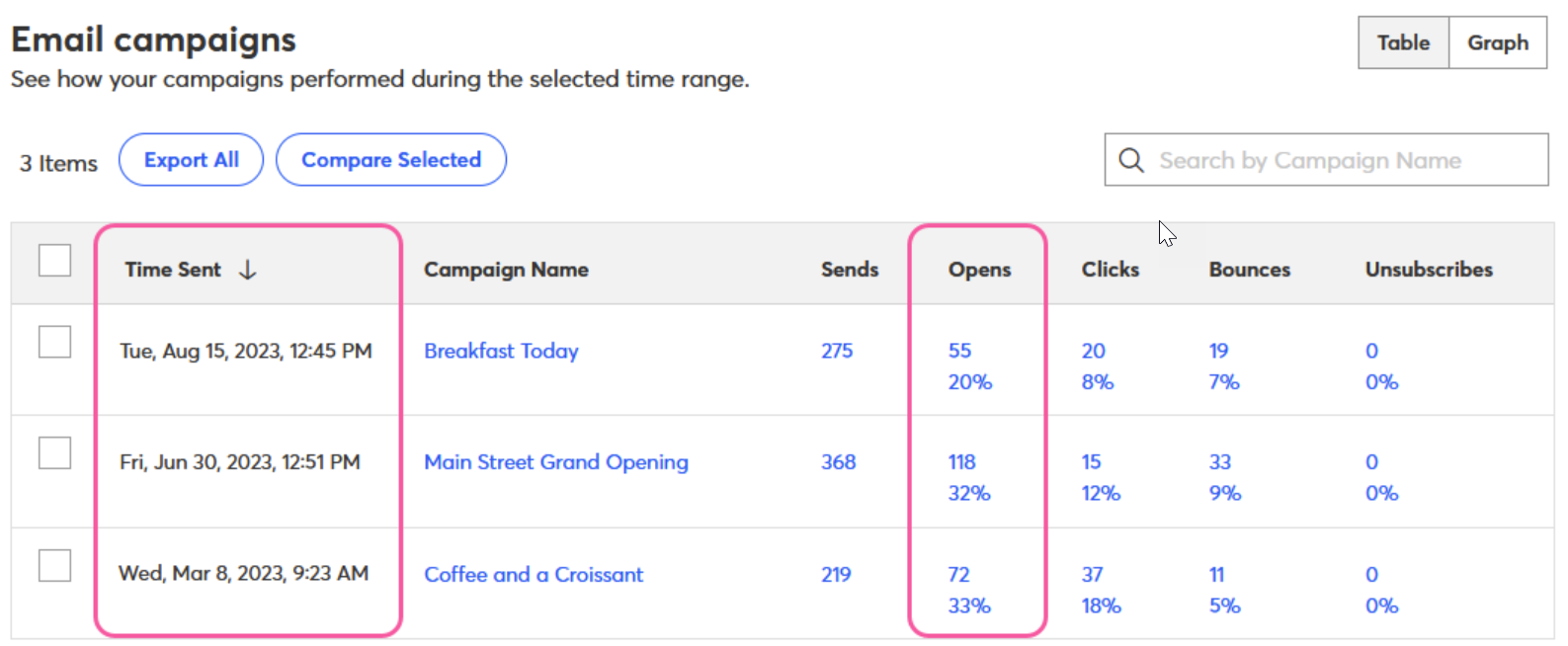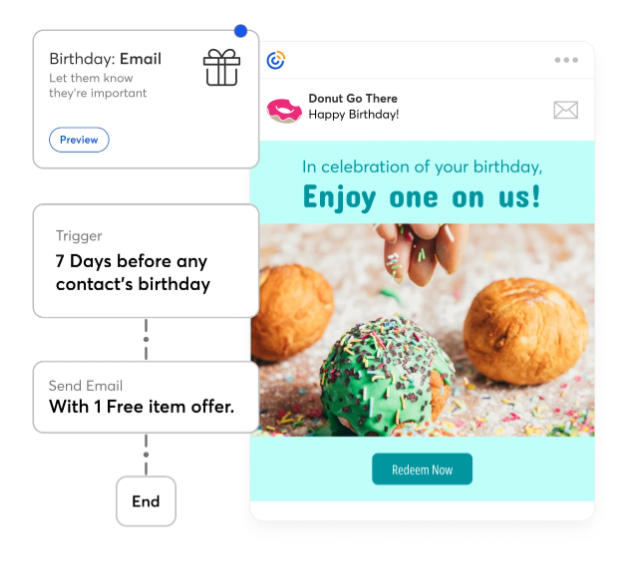
There’s nothing we’d love more than to tell you a magic time and day that would give you the absolute best results for your email marketing campaign.
But while we can’t give you exactly that, we do have more than enough data and proven best practices to offer you something more satisfying than the generic ‘it depends’ answer.
The good news is we have compiled helpful resources and criteria to help you determine the best time and day to send emails for your specific business.
When is the best time to send email marketing campaigns?
We have said it before and we’ll say it again: there isn’t an exact formula to building the perfect email. The same goes for when to send it. Businesses should look at email open times, as well as times of highest engagement through email and website, to understand the optimal time to schedule emails. The team at Salesforce conducted a study to reveal the best time to send a marketing email, finding that mornings and weekdays typically skew higher for open rates than evenings and weekends. And while that data is helpful, it’s probably not granular enough to progress your email marketing strategy on its own. Thus, you’re left with the exciting opportunity to experiment.
One of our own email marketing experts, Maria Halovanic, Director of Customer Lifecycle Management, had this to say: “If you aren’t using a platform that has intelligent sending time, you can refine your sending time through testing and understanding how your subscribers want to engage with you.” That means looking to open rates, click-through rates, unsubscribes, and audience demographics to figure out the best send time, based on the type of content and subscriber.

To start, we’ll dive into everything you need to know about the factors that determine how your target audience is interacting with your emails.
Understanding your target audience
When thinking about the best day or time to send an email, focus on your audience. Think about their routines and when your message has the best chance of reaching them when they have a moment to spare.
Pay attention to the following factors that might influence audience engagement:
- Time of day: Think about how time of day will affect how your audience perceives your communications. Morning emails might work better to reach a target audience of professional women in their 20-30s who have subscribed to a yoga studio. An evening send might favor a target audience of consumers interested in a particular product like home tech gear.
- Industry: Consider the professions that make up your target audience. When and where do your subscribers work or study? For example, say you run an online business that caters to college students; you’ll probably fare better sending emails in the evening when students are out of class.
- Age: The age of your target audience will affect when they are most likely to engage with your emails. Take an audience that is mostly made up of an elderly demographic of retirees. They might want to receive email in the morning or during the day as opposed to evening times reserved for family and friends.
- Routines and behaviors: Data you gather on your target audience’s routines and behaviors will be beneficial in helping you choose appropriate send times. You might notice that subscribers who make appointments with your business tend to log in and check on their appointment information at a specific time. This behavior information can help you determine the best time to send email blasts to cut out unnecessary effort for your clients.
- Time zone and location: Your target audience might fall into different time zones and locations. Schedule emails to send when you know they will reach your audience’s inbox in the middle of the night for their location. Segment your audience to make sure that your emails reach individual subscribers when they are most likely to open.
Additionally, remember that a growing number of people are checking emails on their mobile device. Your audience doesn’t need to be sitting at home or at work in front of a computer to check their emails anymore. This means you’ll need to think differently about how you reach your audience with your email campaigns.
Focus on your campaign goal
In addition to thinking about your audience, think about the timing around the content you’re sending them. For example, if your restaurant is running a limited-time special on appetizers, experiment with sending emails out the day before, or even sending last-minute reminders the day of the special. Some of your subscribers will jump at the opportunity when they receive an email, while others might be more likely to join you the next time they get a chance.
Perhaps you are trying to figure out the best time to send an email newsletter. The goal of your campaign is to provide your audience with helpful content on a regular basis. As you look at analytics, you might notice that subscribers tend to value consistency when receiving a regularly occurring email. Keeping your newsletter send time the same might work best to encourage opens because subscribers will know to look for your content in their inbox.
Tip: Show that your message is timely with your subject line. If you have an event coming up, add the date in the subject line to create a sense of urgency.
Experiment
Testing is especially useful if you’re working with a large email list. Start by segmenting your list into two or three smaller groups and experiment with sending the same message out at different times.
Your test could be by time of day, like morning, afternoon or evening. Or you could try early in the week, mid-week, and weekend.
Keep everything else consistent so that the timing is the only thing that’s unique. Compare the open rates of each mailing, and you can get a clear picture of what’s working the best.
Set expectations
For many businesses, one of the most important aspects of timing will be to choose a time and stick with it. Ideally, you want your contacts to expect to hear from you and be on the lookout for your next message. Be consistent and avoid days and times that are known to be busy, for example holidays and standard meal times. You’ll also find that there are emails that your subscribers will expect to receive — like abandoned carts and birthday messages. Automating these types of email sends will help to instill trust and promote customer loyalty.

Tip: Add a short description including approximate sending times/frequency of emails to your sign-up forms.
How to measure the effectiveness of your email
To measure the effectiveness of your emails, you’ll want to pay attention to click-through rates (CTR). Your click-through rate is the percentage of subscribers who clicked on a link in your email and followed through to the next step. This could be a button with a call to action to register for an event or a product image that brings the subscriber to a product detail page on your website.
To measure the effectiveness of your email’s status in the inbox, pay attention to open rates. You want to be aware that as of September 2021, Apple’s Mail Privacy Protection policy has rendered email open rates, for all intents and purposes, obsolete for marketers looking at open rates for subscribers using Apple products. While this may sound a little scary, remember that there are plenty of subscribers who check their email from a smartphone, laptop, or other device that isn’t an Apple product. Open rates from these subscribers will not indicate if your email was effective in helping you meet a particular goal, but they will help you understand whether subscribers are taking notice of your content in the inbox.
Email open rates by industry
Industry trends are a great starting point when you’re first thinking about the best time to send a marketing email. At Constant Contact, we regularly analyze customer email results to collect industry-specific data to help you know where you stand. Our KnowledgeBase includes up-to-date information on the average open, click-through, and bounce rate trends by industry.
Tip: There’s a good chance you already have plenty of data about what works best for your audience within your email reports. While many factors influence email open rates, be sure to look for patterns that point to optimal times/days.
How to improve email open rates
To make sure your emails are getting noticed in the inbox, test your subject lines to see what types of messages are attractive to subscribers. In order to run an A/B subject line test,, craft two subject lines for the same email. Then, select two subsections of your audience. Make sure the test groups are similar in size, as well as demographic/interest makeup. Select a time threshold to run your test, send your test messages, and wait for your results. Whichever subject line garners the most opens lets you know what type of content is resonating.
Here are some examples of subject line content to juxtapose:
- Urgency versus empathy
- Adopt a pet today
- Bring home a new friend
- Desire versus logic
- You need to add this look to your closet
- [Product] Jeans are on sale for 20% off
Reaching your audience in the right place at the right time
Unlike many other marketing channels, email marketing works not only because you are sending messages to people who have asked to receive them, but you’re also sending those messages directly to a place most people visit every day — their inbox. To start on your quest to find the best time to send a marketing email, make sure you have access to the right data. The history of your previous sends has a lot to say about how your audience is interacting with your content. Constant Contact has your back in that department. Test out our email tracking software to see the insights you need to make informed decisions. Knowledge is power – so start sending.





